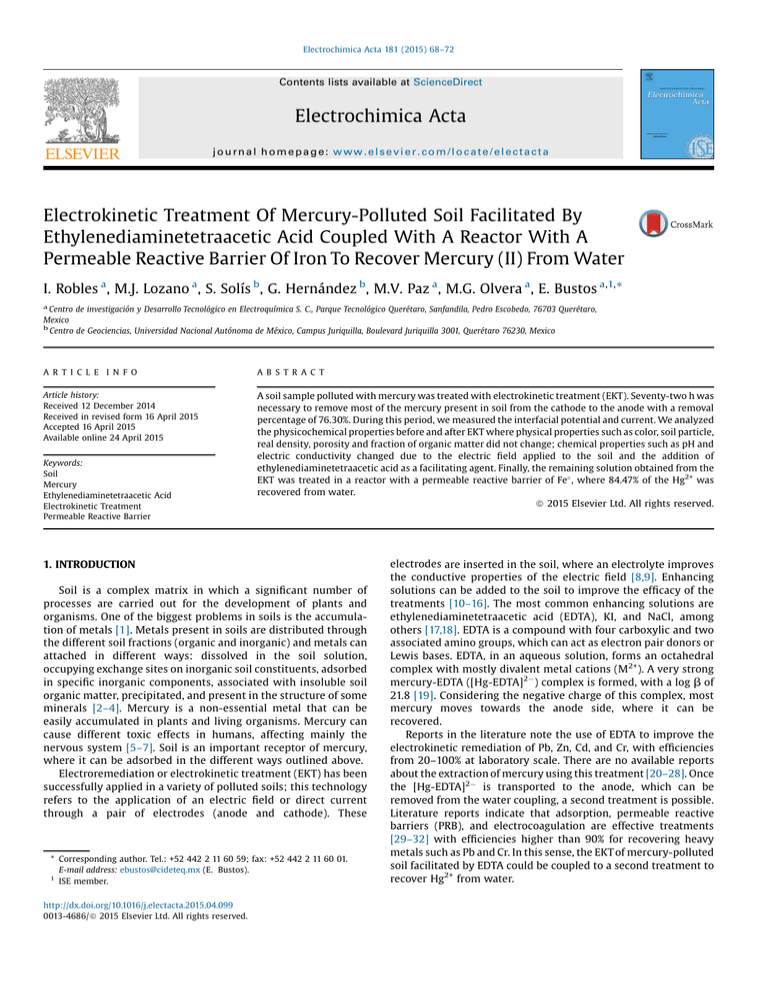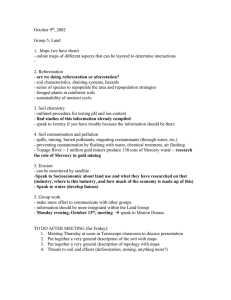
Electrochimica Acta 181 (2015) 68–72
Contents lists available at ScienceDirect
Electrochimica Acta
journal homepage: www.elsevier.com/locate/electacta
Electrokinetic Treatment Of Mercury-Polluted Soil Facilitated By
Ethylenediaminetetraacetic Acid Coupled With A Reactor With A
Permeable Reactive Barrier Of Iron To Recover Mercury (II) From Water
I. Robles a , M.J. Lozano a , S. Solís b , G. Hernández b , M.V. Paz a , M.G. Olvera a , E. Bustos a,1, *
a
Centro de investigación y Desarrollo Tecnológico en Electroquímica S. C., Parque Tecnológico Querétaro, Sanfandila, Pedro Escobedo, 76703 Querétaro,
Mexico
b
Centro de Geociencias, Universidad Nacional Autónoma de México, Campus Juriquilla, Boulevard Juriquilla 3001, Querétaro 76230, Mexico
A R T I C L E I N F O
A B S T R A C T
Article history:
Received 12 December 2014
Received in revised form 16 April 2015
Accepted 16 April 2015
Available online 24 April 2015
A soil sample polluted with mercury was treated with electrokinetic treatment (EKT). Seventy-two h was
necessary to remove most of the mercury present in soil from the cathode to the anode with a removal
percentage of 76.30%. During this period, we measured the interfacial potential and current. We analyzed
the physicochemical properties before and after EKT where physical properties such as color, soil particle,
real density, porosity and fraction of organic matter did not change; chemical properties such as pH and
electric conductivity changed due to the electric field applied to the soil and the addition of
ethylenediaminetetraacetic acid as a facilitating agent. Finally, the remaining solution obtained from the
EKT was treated in a reactor with a permeable reactive barrier of Fe , where 84.47% of the Hg2+ was
recovered from water.
ã 2015 Elsevier Ltd. All rights reserved.
Keywords:
Soil
Mercury
Ethylenediaminetetraacetic Acid
Electrokinetic Treatment
Permeable Reactive Barrier
1. INTRODUCTION
Soil is a complex matrix in which a significant number of
processes are carried out for the development of plants and
organisms. One of the biggest problems in soils is the accumulation of metals [1]. Metals present in soils are distributed through
the different soil fractions (organic and inorganic) and metals can
attached in different ways: dissolved in the soil solution,
occupying exchange sites on inorganic soil constituents, adsorbed
in specific inorganic components, associated with insoluble soil
organic matter, precipitated, and present in the structure of some
minerals [2–4]. Mercury is a non-essential metal that can be
easily accumulated in plants and living organisms. Mercury can
cause different toxic effects in humans, affecting mainly the
nervous system [5–7]. Soil is an important receptor of mercury,
where it can be adsorbed in the different ways outlined above.
Electroremediation or electrokinetic treatment (EKT) has been
successfully applied in a variety of polluted soils; this technology
refers to the application of an electric field or direct current
through a pair of electrodes (anode and cathode). These
* Corresponding author. Tel.: +52 442 2 11 60 59; fax: +52 442 2 11 60 01.
E-mail address: ebustos@cideteq.mx (E. Bustos).
ISE member.
1
http://dx.doi.org/10.1016/j.electacta.2015.04.099
0013-4686/ ã 2015 Elsevier Ltd. All rights reserved.
electrodes are inserted in the soil, where an electrolyte improves
the conductive properties of the electric field [8,9]. Enhancing
solutions can be added to the soil to improve the efficacy of the
treatments [10–16]. The most common enhancing solutions are
ethylenediaminetetraacetic acid (EDTA), KI, and NaCl, among
others [17,18]. EDTA is a compound with four carboxylic and two
associated amino groups, which can act as electron pair donors or
Lewis bases. EDTA, in an aqueous solution, forms an octahedral
complex with mostly divalent metal cations (M2+). A very strong
mercury-EDTA ([Hg-EDTA]2 ) complex is formed, with a log b of
21.8 [19]. Considering the negative charge of this complex, most
mercury moves towards the anode side, where it can be
recovered.
Reports in the literature note the use of EDTA to improve the
electrokinetic remediation of Pb, Zn, Cd, and Cr, with efficiencies
from 20–100% at laboratory scale. There are no available reports
about the extraction of mercury using this treatment [20–28]. Once
the [Hg-EDTA]2 is transported to the anode, which can be
removed from the water coupling, a second treatment is possible.
Literature reports indicate that adsorption, permeable reactive
barriers (PRB), and electrocoagulation are effective treatments
[29–32] with efficiencies higher than 90% for recovering heavy
metals such as Pb and Cr. In this sense, the EKT of mercury-polluted
soil facilitated by EDTA could be coupled to a second treatment to
recover Hg2+ from water.
I. Robles et al. / Electrochimica Acta 181 (2015) 68–72
The novelty of this paper is that we combine the EKT of
mercury-polluted soil facilitated by EDTA as a complexing agent
and the ensuing removal of mercury from water using PBR of Fe .
2. EXPERIMENTAL
2.1. Reagents
Mercury-polluted soil was taken from a mine site located in San
Joaquín, Queretaro, Mexico with an initial concentration of
656.27 mgKg 1. The soil sample was mixed before EKT [9]. EDTA,
disodium salt dehydrate from J. T. Baker brand was used to enhance
the EKT. After EKT, a PRB of Fe obtained from Sigma Aldrich was
used to recover the mercury.
2.2. Methods
For the EKT, an acrylic rectangular cell 64 cm3 in volume and Ti
rectangular plate electrodes (2 5.5 cm, Tepsa, Mexico City) were
used as the anode and cathode, respectively. Their separation was
6 cm. Twenty volts was applied as the potential of the cell during
EKT to 25 g of polluted soil using a DC Power Supply GP 4303DU (EZ
Digital Company, Korea). The experiments were carried out at
room temperature. During EKT, the current and corresponding
interfacial potential were measured at each electrode.
Mercury was quantified in the extracted solution on the
electrode side, and also measured in the soil before and after
treatment. To this end, the soil was divided into six equal-sized
parts 1 cm away from the cathode to the anode (Fig. 1).
We measured mercury in an aqueous solution using anodic
striping voltammetry (ASV), and we also corroborated our results
using atomic absorption (AA). ASV was measured in an electrochemical cell with three electrodes: vitreous carbon, Ag|AgCl, and a
Pt wire. These electrodes function as working, reference, and
counter electrodes, respectively. A pre-concentration potential of
0.6 V, a deposition time of 5 min, and a rest period of 40 s were
applied before a scan potential of 20 mVs 1. A Potentiostate Galvanostat Bas - Epsilon (Bioanalytical Instruments, USA) was
used for this purpose. To quantify the mercury content using AA,
the samples were pre-treated with microwave digestion using
5 mL of 2% HNO3 solution; deionized water was add to each sample
to obtain a final volume of 50 mL of solution. These liquid samples
were digested using a MarsX microwave according to protocol
3015A-EPA-2007 [33]. In the case of solid samples, 0.5 g of soil was
digested according to protocol NOM-004-SEMARNAT-2002 [25]. At
the end of the digestion procedure, deionized water was added to
the supernatant of each sample to obtain 100 mL of solution; for
Fig. 1. Rectangular system employed to carry out the EKR with an acrylic
electrochemical cell, including a Ti cathode and anode separated by 6 cm. The
solution containing mercury was removed from the anodic compartment with a
pump to an acrylic cylindrical cell containing a PRB of Fe to remove the mercury
from the solution.
69
the analysis of these samples, an AA Aa400 Perking Elmer coupled
to FIAS 100 equipment was used. We employed a hydride
generator technique via cold vapor following the methodology
reported in protocol NOM-004-SEMARNAT-2002 [34].
We conducted a physicochemical characterization of the soil
before and after EKT. pH, electric conductivity, color, size particle,
real density, porosity, and fraction of organic matter were
compared. pH and electric conductivity were estimated according
to procedures NMX-AA-008-SCFI-2000 [35] and NMX-AA-093SCFI-2000 [36], respectively, using a Hanna pH-meter (Hanna
Instruments, USA) and a YSI-3200 conductimeter (Cole-Parmer,
USA). Color, size particle, real density, porosity, and fraction of
organic matter were analyzed according to NOM-021-SEMARNAT2000 [37] and ISRIC [38] protocols. All soil analyses were
conducted in duplicate.
The electrodes were also characterized before and after EKT
using scanning electron microscopy (SEM). SEM was conducted
using 15 kV of voltage acceleration and 100x with a Jeol
JSM-5400LV scanning electronic microscope (JEOL, USA). After
EKT, the extracted solution with [Hg–EDTA]2 was treated to
recover Hg using a flux reactor with a PRB of Fe [39], where 18 g of
iron was needed to treat 250 mL of Hg solution. We also used a flux
of 120 mLmin 1, using a MasterFlex peristaltic pump (ColeParmer, USA). The sample was collected and analyzed using ASV.
3. RESULTS AND DISCUSSION
After 72 h, the mercury in the cathodic side was negligible,
which indicates that the [Hg-EDTA]2 complex was formed and
transported to the anodic side. The current (Fig. 2A) should be
proportional to the mercury concentration close to the anode, as
can be seen in Fig. 2A. Seventy-two h was sufficient to remove most
of the mercury present in the soil. After that time, the remaining
mercury is removed too slowly due to there being specific soil
fractions where mercury bonds very strongly. These soil types
include exchangeables, clays, oxides, sulfurs and residual fractions
[40], which is why 72 h is sufficient to remove mercury
electrochemically. pH during EKT varied between 4 and 5
(Fig. 2B) due to the physicochemical composition of the soil and
the addition of EDTA. The electric conductivity changed and
increased from 10 to 15 mScm 1 in the presence of the [HgEDTA]2 complex generated during EKT (Fig. 2C).
During the 72-h EKT, an average current of approximately 0.15 A
was observed. The interfacial potential was measured on both
sides of the electrodes. The potential was 1.42 V on the cathodic
side and 1.41 V on the anodic side, although the latter slowly
increased to attain a value of 2.75 V. This increment can be
attributed to the reaction of mercury movement towards the anode
compartment, such as the [Hg-EDTA]2 complex.
After the EKT, we measured the mercury content using ASV.
These results were corroborated by AA on the anodic side and the
different soil portions between both electrodes. A mercury
recovery rate of 76.30% was obtained from the soil. We measured
the remaining mercury in the soil to the anode to determine how
mercury was moving towards the anode. Table 1 lists the
percentage of mercury remaining in the soil fractions; one can
clearly see that a larger fraction of mercury is present near the
anodic side because the [Hg-EDTA]2 complex moves towards the
anode. A percentage of 2.8% was recovered close to the cathode and
4.8% close to the anode. This trend can be described by a
logarithmic increase represented by the equation: Hg = 1.161 ln
(d) + 2.677 with R2 = 0.981, where Hg is given in percent and d
represents the distance from the cathode to the anode. This
equation was obtained from these data based on the different
transport phenomena generated during EKT [9–17]. Our results
accordingly explain why more mercury remains on the anodic side.
ID
183473
Title
ElectrokineticTreatmentOfMercury-PollutedSoilFacilitatedByEthylenediaminetetraaceticAcidCoupled
WithAReactorWithAPermeableReactiveBarrierOfIronToRecoverMercury(II)FromWater
http://fulltext.study/article/183473
http://FullText.Study
Pages
5



